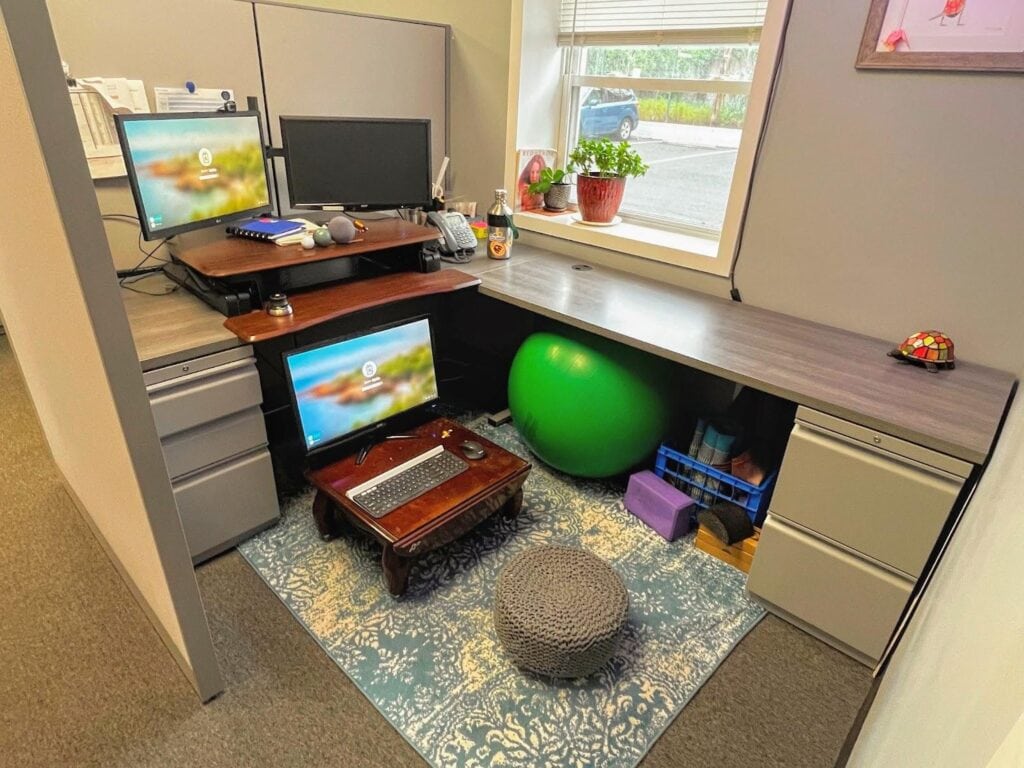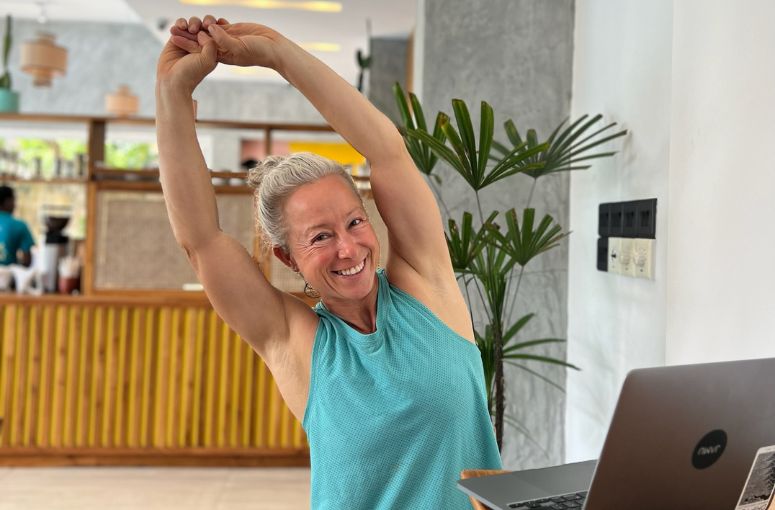Modern lifestyles have become increasingly sedentary with many of us glued to desks for hours each day. While moving more sounds great in theory, when you’re stuck at work most of the day, it’s tough to find the time.
Enter the movement friendly workstation! Setting up your desk so you can stand, sit on the ground or a ball, and generally move around while you work can be a true game changer! In fact, it’s one of my absolute favourite ways to sneak lots more movement into your day without adding any extra time.
Feeling a bit lost on where to begin? Keep reading for a bunch of awesome ideas from me and my community to inspire you and help kickstart your movement journey!
Petra’s Movement-Friendly Workstation Essentials
Since I travel full time I’m really all about making it work wherever I am. This sometimes means less-than-perfect solutions, but I do have a list of movement-friendly workstation essentials I try to stick to no matter where I am.
👉 I try to avoid chairs and opt for either floor-level or standing workstations instead.
👉 I use different types of movement equipment to make both options more dynamic – so for instance I’ll often do some calf stretching or foot mobility work as I’m standing, and I switch positions often when I’m on the floor.
👉 I use a timer to remind myself to move every 15-30 minutes. I switch things up to add variety but usually I try to step away from my computer and take a true 2-5 minute whole body movement break – a short walk, hanging from my gym rings, crawling on the ground, balancing, etc.
There are also a few items that I don’t currently use but plan to buy the next time I’m in Canada: a laptop stand, a portable keyboard and a wireless mouse. These items would allow me to set up my screen & mouse a bit more optimally (mid-screen at eye level and the keyboard just below elbow height).
Essentials for a movement-friendly standing workstation
There are all sorts of standing desks out there these days. No matter what kind you’re using there are two key things to think about:
1️⃣ Make sure to keep it dynamic with lots of props to play with, and
2️⃣ Learn hips-over-heels alignment – see this video for exactly what hips-over-heels means
True story, I got plantar fasciitis from switching to a standing workstation back when I worked in an office and before I discovered movement and alignment work. How you stand can have a BIG impact on your feet! (Not to mention your low back, hips & pelvic floor.) Learning to stand hips over heels can be HUGE and delivers a lot of long term benefits to your body.
But don’t just stand there! If all you do at your workstation is stand still, you’re missing out on the possibilities of a standing workstation. Instead, think about ways to gently stretch, squat and move while you’re standing. Here are a few items I recommend that you keep nearby if you plan on using a standing desk.
👉 Half round foam roller – use for calf stretching & balancing
👉 SoleMate – use for balancing
👉 Balls – for foot rolling
(For links to these items and other movement gear I love & use often, click here)
Here are a few of my favourite standing workstation moves to get you thinking about how you can get the most benefits from your set up!
You may also want to get something like an anti-fatigue mat if your floors are hard – my partner Chris used to use the Topo mat from Ergodriven when he still worked at an office but a more simple mat can work fine too!
Essentials for a movement-friendly workstation at ground level
One of the major benefits of a ground level workstation is that it requires frequent, varied movement. Not only do you need to get up and down from the floor, but you’ll also end up exploring various seated positions. This is wonderful for giving our hips lots of variety and our knees & ankles more full range of motion movement – as well as building muscle getting up & down. Plus, you’ll use your core all day long to support your body instead of relying on a chair or wall to support you.
For a floor sitting workstation you’ll probably want to have something to sit on. Most people have adapted to sitting in chairs, so just sitting on the ground can be more of a strain on our bodies than a help. Sitting on a half-round roller, firm cushions or a yoga bolster (in any combination) will help you meet your body where you’re at and be more comfortable, while still getting the hip mobility & core strength benefits of being on the ground. See this blog post for tips on getting comfortable sitting on the ground!
Want small, simple exercises that fit into your day?
One thing I don’t recommend is getting a ‘chair’ with a backrest or anything you can lean on. This takes away the benefits of using your core to hold your body up in space. The exception to this is if you need a break – then go ahead, lean back & enjoy!
Need some ideas on how to get lots of movement variety as you sit and work? Try this!
Real Life Examples Of Amazing Movement-Friendly Workstations
So because I really just use whatever I find around me, I don’t have great decor ideas for my work station set up! So I reached out to my amazing community members to ask what YOU’RE using. There are some great, creative ideas here that range from the simple and DIY to the more fancy – which set up do you think would work best for YOU?
#1 – Morgan’s foot-friendly standing workstation

What Morgan says:
“As much as I love floor sitting, having a work area on the ground doesn’t work for me with two little kids running around. That’s why I decided on an adjustable standing desk. While I prefer to stand, I like having the option to lower the height and sit and wiggle around using the big pink exercise ball (this was especially helpful when I was dealing with plantar fasciitis and unable to stand for long periods).
Having many props nearby encourages me to take movement breaks and offers lots of opportunities to move while working at the same time – yay multitasking! Some of my favorite exercises to do are calf raises and stretches using my half dome, top of the foot stretch, rolling out my foot on balls of varying textures/sizes and pelvic listing using my cork yoga block. My summer project is to make a textured mat to stand on using rocks my kids and I have collected during our walks to the river. Right now, I have a few small rocks I use to provide my feet with more sensory input.”
#2 – Nicole’s family-friendly ground level workstation


What Nicole says:
From Katy Bowman’s blog to CARS now, I have never stopped searching, observing and learning how we can heal, move, and connect with our bodies. This is my final step in my natural body movement journey, which began 7 years ago, when I said to myself: ‘my physiotherapist’s exercises aren’t natural, I’m not going to get stuck in them!’
After cutting down the legs of my kitchen table, I decided to create my own desk, and another one for my 9 year old daughter. I wanted a table that was long, light and easy to move. I placed it in a space where I could easily move myself, or take equipment to change the way I sit or do exercises while working or studying. I love them, they are more than just furniture, they represent this whole journey with back- and- forth steps, inner growth and change in our mind and body. It’s such a fulfillment every day!
#3 – Abigail’s ergonomic movement-friendly office

What Abigail says:
“My movement-friendly office consists of two nesting tables (35cm and 25cm high respectively), a split keyboard and ergonomic mouse, and floor chair plus yoga props. I sit forward on the cushion, unsupported by the backrest, while working, and I lean back and enjoy a deep spinal stretch during eye breaks. (I unscrewed the chair’s foam seat and replaced it with a 3″ high buckwheat meditation cushion.”
#4 – Jason’s insanely creative movement-friendly cubicle workstation transformation

What Jason says:
“I’ve done my best to adapt this small space into a cost-effective but fully functional movement-friendly area. I made the floor laptop stand & gray floor cushion myself by cutting off the legs from an inexpensive table & old stool. I added a wheel to each leg on the table so I can easily roll it in and out from underneath my desk. I also have a wireless keyboard & mouse that I move between my desk and floor table.
I like to alternate between four different positions: standing, seated on an exercise ball, kneeling on one knee, and sitting on the floor.
When standing I always have one foot on a half round or a balance board I made from scrap wood. I’ll also roll out my feet using an assortment of balls I keep under my desk.
If I’m sitting on the exercise ball I get as much movement in as possible by bouncing, rolling side to side or sometimes just laying back in a bridge/wheel type position.
Kneeling on one knee is my favorite because there’s so much movement you can do. Moving my hips feels really good but I also like to straighten/bend/elevate the front leg and get a good hamstring stretch in.
If I’m working at ground level I move around a lot – alternating between a wide V position, one leg forward/one leg back, sitting cross legged or in a butterfly position. I do whatever feels right at the time and don’t have one set position I stick to.
Besides changing up positions, I try to put everything out of reach or in an inconvenient location so that I have to stretch/bend/move to get it. I also have lots of props around to encourage movement. I have a foam wedge for squatting, a half foam roller, a sit pad and a 5 lb weight.”
Petra’s note: I love the way that Jason has a full size monitor at both of his desks – I know lots of people struggle with this when they need to have big screens for their jobs. And what really stands out to me is how many movement options he’s created in a small space – really proving how far you can go with enthusiasm and creativity!
#5 – Sohail’s multi-purpose Movemate workspace


What Sohail says:
“The first setup includes a standing desk at a fixed height, a ground-level sitting desk, and a small play area. It’s designed for flexibility, allowing you to alternate between standing and moving using the Movemate board and sitting on the ground while working. Additionally, there’s an open space for movement breaks, with access to both the balance beam and the Movemate board. This layout minimizes the effort of transitioning between different working positions during the day.
This setup features an adjustable-height desk paired with a Movemate board for an effortless transition between sitting, standing, and moving. The desk is positioned against the wall because of the limited space and minimal aesthetic. The Movemate board’s small footprint and natural look allow it to be conveniently stored under the desk or against the wall when not in use without sacrificing visual appeal or occupying too much room.”
Note from Petra: I asked Sohail to share his set up because I think the Movemate is a suuuper cool workstation addition. It’s a great way to invite more play and movement into your desk-bound workday and help you feel, work and live better! If you want to learn more about Movemate, click this link. I’m not an affiliate, I just think it’s amazing.
While I was in Toronto I had a chance to meet Sohail & Ali, the team behind Movemate, and to give the board a try. Spoiler alert – it’s awesome, and it’s not like anything else you’ve tried before. This video shows what I thought about my experience.
#6 – Adrienne’s versatile but low-tech adjustable floor desk setup


What Adrienne says:
“My desk is from a company called Desk Stand, based out of South Africa. They actually market it as a standing desktop that can be placed on any surface, but I think they have an untapped market with floor desks as well! This desk can really do it all. The top level adjusts to have my computer at eye level when needed, with space below for taking notes during Zoom calls. It can also be moved up and out of the way when needed.
I have a Mexican blanket and folding kapok zafu cushion to sit on which allows adjustable bolstering height. This allows for plenty of seating positions and frequent adjustments. There’s also plenty of space for my cat to curl up and join in my work, which she loves.
I have this setup currently in the corner of my bedroom but it can pretty easily move wherever I want it inside or outside. I cozied it up a bit with a few “office” gifts from my mom. Overall it’s a very functional but also cozy work space.”
#7 – Ginger’s simple DIY movement-friendly floor-level workstation

What Ginger says:
“I just grab what’s around me. I sit on a yoga block or foam roller. I use my son’s table and chairs. I will turn around and use the bottom of the sofa to lean on because my back gets tired and hurts.”
Making your workstation dynamic can be a huge win for your body – and your busy day! Hopefully the creative juices are flowing and this post has given you lots of ideas to help you create your own movement-friendly workspace & integrate more movement into your work day!
(For even more inspiration, take a look at this Reddit community devoted entirely to dynamic workspaces.)
Finally, if you love these ideas and want more even movement tips & exercises that you can add to workday, I have amazing news for you! I’ve created a new program packed with totally doable ‘Mini Moves’ that you can literally do any time, any where (no matter what else is going on, no special equipment needed). I’m suuuper excited to share these. If you’re ready to learn small but powerful exercises to move more, click here to get started today!
Want short & sweet exercises you can do even when life is busy?
Sign up for my new Mini Moves program and learn super do-able exercises that give your body more movement all day long – no gym, studio or special equipment required!







